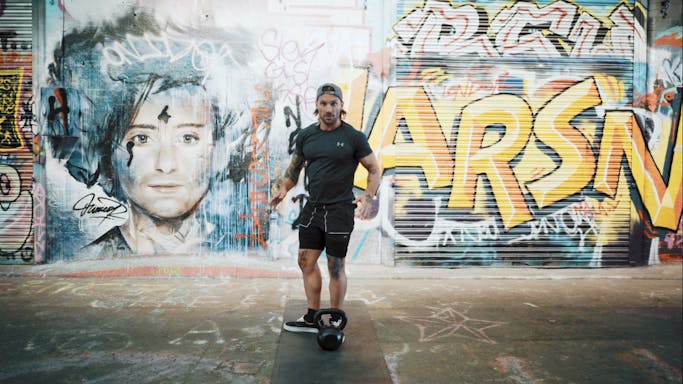Kettlebell Snatch
by Sam Franklin
How to Master The Kettlebell Snatch: The Speed & Power Booster
One of the ultimate head to toe exercises, the kettlebell snatch offers the perfect mix of cardio workout and strength training.
Transferring from a low to a high position in one big sweeping movement, getting this most effective of kettlebell exercises just right is essential if you want to avoid injury.
To help you get the most from your kettlebell snatch efforts and inspire you to get swinging, here’s a handy guide.
Let’s go.
How to do a kettlebell snatch: video tutorial
Before we dive into the benefits of kettlebell snatch, watch our quick tutorial video by Luke Baden, Kettlebell Master Trainer.
Luke will take you step by step through the entire movement, ensuring your form is correct and you get the absolute maximum out of the exercise.
Step by Step Guide to the Kettlebell Snatch
Step 1: The Kettlebell Snatch
The Kettlebell Snatch is a complicated manoeuvre, so it is recommended that you learn it in layers. The first layer to learn is the Kettlebell Single Arm Swing and the second layer is the Kettlebell Swing High Pull. Make sure you watch those videos and master those first, before trying the Kettlebell Snatch.

Step 2: The Kettlebell Snatch
To start, stand with your toes against the kettlebell. Turn one foot 90 degrees, then again turn 90 degrees. Repeat on the other side. You should now be positioned with feet shoulder width apart and just behind the kettlebell.

Step 3: The Kettlebell Snatch
Chop and drop your hips to find your hinge point. Put one hand on the bell and the other arm comes forward.

Step 4: The Kettlebell Snatch
Throw the kettlebell back through the legs, then swing forward, push up and punch through at the top. At the top, the kettlebell should be as low in the hand as possible.

Step 5: The Kettlebell Snatch
To go down, rotate the wrist, let the kettlebell drop and catch it in your fingers. Try to get the forearm back to the body and then bend down into the hinge position.

Step 6: The Kettlebell Snatch
Swing the kettlebell back through the legs, swing forward, big hip drive and punch up and through. When you've done your reps, park the kettlebell.

The body-boosting benefits of the kettlebell snatch
Demanding and dynamic, the kettlebell snatch boasts a wealth of body-boosting benefits for anyone looking to improve their fitness. Here are the main ones:
- Fat loss: As an energy expelling, heart rate raising kettlebell exercise, the snatch engages literally hundreds of muscles in a single sweeping movement, offering excellent fat-burning benefits as a result.
- Power boost: By developing your ability to produce force at speed, the kettlebell will help you increase your strength and power effectively. In fact, this is one of the best overall strength and power-boosting kettlebell exercises around.
- Movement: An exercise that connects the body from head to toe, the kettlebell snatch will aid your overall movement and coordination skills.
- Stability: As the kettlebell snatch engages both the upper and lower body, performing this exercise frequently will condition your muscles, making you more stable and resilient.
What muscle groups does the kettlebell snatch work?
As an excellent top to bottom kettlebell exercise, the snatch helps to enhance major muscle groups throughout the body—but here are the areas it works the most:
- Shoulders: The kettlebell snatch offers an excellent all-round shoulder workout, boosting overall upper body strength and stamina.
- Core: The core is the very foundation of your strength and fitness, dictating how effectively you’re able to perform most kettlebell exercises. The snatch is a particularly effective core building exercise, making it an essential tool for improving your overall fitness and wellbeing.
- Quads: As incredibly powerful extensors of the knee joints, the quad muscles are pivotal to overall leg strength, stamina, flexibility, and durability. Working on this muscle group will help you perform better at a variety of sports and activities while boosting your overall fitness levels no end.
- Hamstrings: The leg muscle group that assists general lower body health, flexibility, and strength, keeping your hamstrings in shape is essential if you want to remain robust and resilient.
Kettlebell snatch form tips
What to do
To reap the rewards of any kettlebell exercise and maximise your workout, getting your form just right is essential—the snatch is no exception. Here are some top tips to ensure your kettlebell snatch is just right.
- Starting position placement: Start with your kettlebell on the floor placed slightly in front and right in the centre of your feet. Make sure that your feet are shoulder-width apart and your toes are pointing forwards.
- Bending and hingeing: Choose a hand and with a straight back, bend your knees slightly hinging your hips forward (maintaining good posture). Grip your kettlebell and pull it back between your legs to gain momentum, making sure that your thumb is pointing backwards (towards you).
- Hip positioning: Push your hips forwards and straighten your back to start the upward movement, pulling the kettlebell to chest height with extended arms.
- The finish: Once your kettlebell rises above chest height, gently pull it back and slide your fist around and underneath it in a swift movement, before punching to the sky or ceiling so it rests softly on the back of your wrist with your arm extended straight above your head.
What to avoid
The kettlebell snatch is an advanced move that you must handle with care. To prevent injury, here’s what you should avoid when performing snatches.
- Don’t run before you can walk (or snatch before you can swing). Make sure you’ve got some kettlebell experience under your weight belt before attempting a snatch—work on the related exercises detailed below and once you’ve mastered those, progress onto the snatch.
- Don’t punch up at the end until the kettlebell is resting on the back of your hand. Getting your timing wrong consistently could cause unnecessary wear and tear on your body in the long run.
- Don’t perform kettlebell snatches right at the start of your workout. Make sure that your body is warmed up before performing this most dynamic of movements.
- Don’t strain to complete the movement. If you are straining too hard, it might be a sign that you need a little more kettlebell experience or that you need to reconsider your kettlebell weight.
Related kettlebell snatch exercises
Last but certainly not least, if you want to amp up your kettlebell snatch session, here are three related kettle exercises to consider:
The Kettlebell Snatch video transcript
This is the video tutorial for the kettlebell snatch.
So, this is a really complicated movement, so I encourage you to learn this in layers.
So, the first layer you want to learn is a kettlebell single arm swing. Make sure you watch that video.
After that, the swing high pull, where we generated this moment of weightlessness before we go back down.
So the kettlebell snatch takes the kettlebell from this position, hike pass, we drive up, we generate this moment of weightlessness around 11 o’clock, and then, as the kettlebell is weightless, we’re going to punch towards the bell, here, and then fix the kettlebell overhead.
On the way down, there are a few ways to go back. You can flip the bell off the wrist, but I like to rotate the bell out of my hand.
Here, try and get the forearm back to the body before we go back into that swing.
So, if you think about it, every rep starts the same as a single arm swing, except there’s just more power from the hips.
We bend at the elbow, bend at the wrist. Find this moment of weightlessness.
When we’ve crowned that we’re going to release the bell in the hand and punch towards the bell.
That’s going to allow the kettlebell to come to the forearm and then we’re going to fix that kettlebell overhead to finish the rep.
Again, on the way down, you can flip it over, but I prefer to corkscrew the hand, let the kettlebell drop, I’m not controlling it, get the forearm back to the body into that hinge position.
So, looks like everything the same as a swing high pull.
Tip toes on bell, 90, 90, same for the other side. Chop and drop the hips. Single hand on bell, free arm comes forward.
Throw kettlebell through legs. Big drive and punch through at the top.
On the way back down, rotate the bell, so rotate, find the hinge and drive up.
Rotate away, find your hinge and drive up.
At the top, the kettlebell should be as low in the hand as possible. On the way down, I want to catch the bell in the fingers.
So, I’m here, low in the hand, rotate, catch in fingers, big hip drive and punch through.
Here, catch in fingers, rotate and drive through. Park the bell once you’ve done your reps.
So, things to remember. It’s the same as the swing. It’s the same as a swing high pull.
Here, generate this moment of weightlessness and then punch towards the bell and the hand is going to move through the horn to this shape.
Once we’ve fixed overhead, the horn is low in the hand.
On the way down, as we cast away, the horn has to move from here, is caught in the finger ends and we’re back into our single arm swing.
To get better at this movement, practice your single arm swings. Practice your single arm swing high pulls and, when you’re ready, high pull, and then go for a snatch. High pull, and then go for a snatch.
That might look like: setting up, high pull for one rep, then go for your snatch. Rotate, catch in fingers. High pull for one rep. High pull and punch through, finding that snatch position.
That was your tutorial video for the kettlebell snatch.
